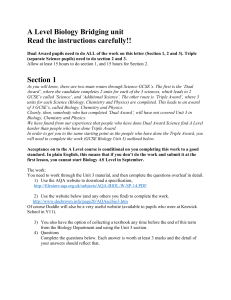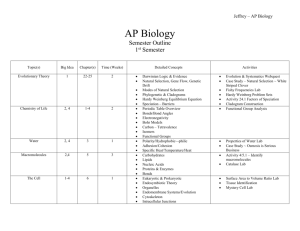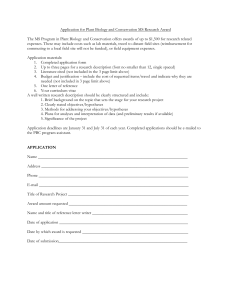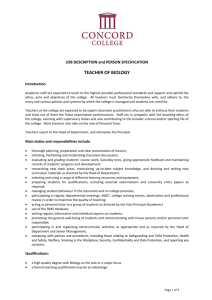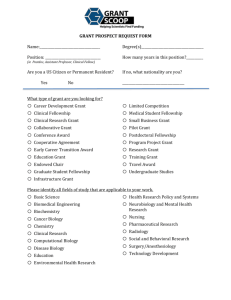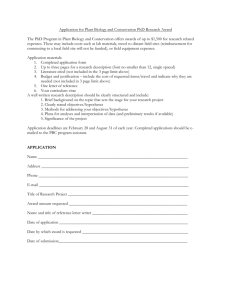File - Keswick Biology
advertisement
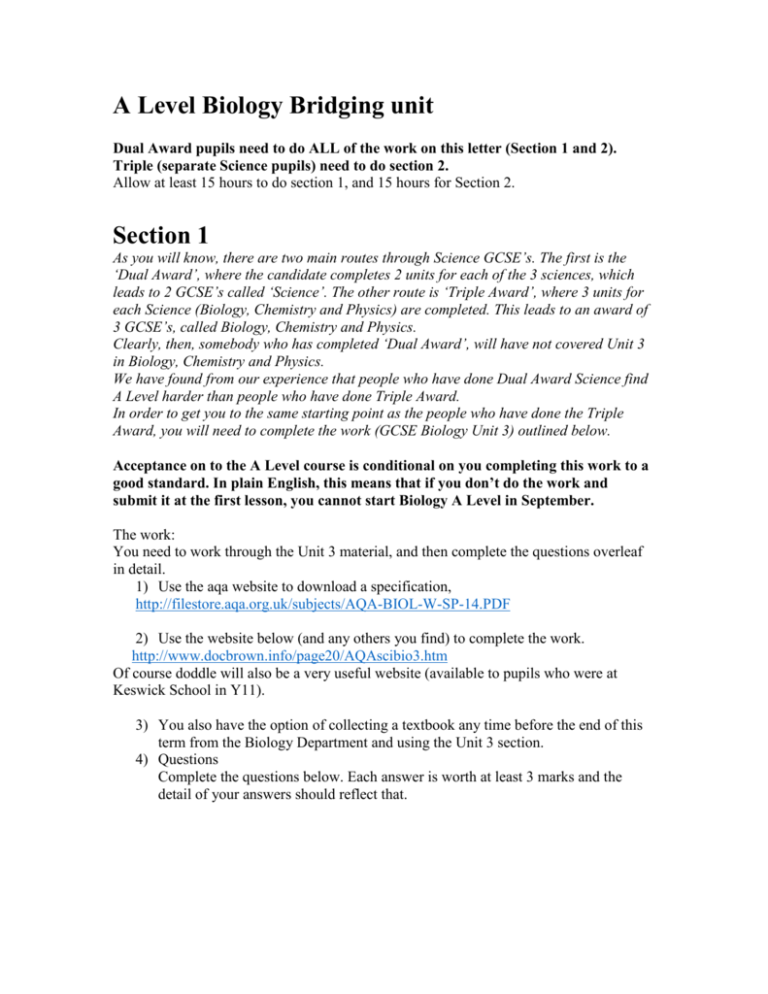
A Level Biology Bridging unit Dual Award pupils need to do ALL of the work on this letter (Section 1 and 2). Triple (separate Science pupils) need to do section 2. Allow at least 15 hours to do section 1, and 15 hours for Section 2. Section 1 As you will know, there are two main routes through Science GCSE’s. The first is the ‘Dual Award’, where the candidate completes 2 units for each of the 3 sciences, which leads to 2 GCSE’s called ‘Science’. The other route is ‘Triple Award’, where 3 units for each Science (Biology, Chemistry and Physics) are completed. This leads to an award of 3 GCSE’s, called Biology, Chemistry and Physics. Clearly, then, somebody who has completed ‘Dual Award’, will have not covered Unit 3 in Biology, Chemistry and Physics. We have found from our experience that people who have done Dual Award Science find A Level harder than people who have done Triple Award. In order to get you to the same starting point as the people who have done the Triple Award, you will need to complete the work (GCSE Biology Unit 3) outlined below. Acceptance on to the A Level course is conditional on you completing this work to a good standard. In plain English, this means that if you don’t do the work and submit it at the first lesson, you cannot start Biology A Level in September. The work: You need to work through the Unit 3 material, and then complete the questions overleaf in detail. 1) Use the aqa website to download a specification, http://filestore.aqa.org.uk/subjects/AQA-BIOL-W-SP-14.PDF 2) Use the website below (and any others you find) to complete the work. http://www.docbrown.info/page20/AQAscibio3.htm Of course doddle will also be a very useful website (available to pupils who were at Keswick School in Y11). 3) You also have the option of collecting a textbook any time before the end of this term from the Biology Department and using the Unit 3 section. 4) Questions Complete the questions below. Each answer is worth at least 3 marks and the detail of your answers should reflect that. Summary Questions – Exchange, Transport & Homeostasis 1. 2. 3. 4. 5. Define osmosis Define active transport Give 3 biological examples of where osmosis or active transport would take place Define isotonic How do isotonic drinks help to rehydrate cells after exercise? (Remember to refer to the processes e.g. diffusion/active transport/osmosis) 6. What 3 features of the lungs make them a good surface for gas exchange? 7. Describe the process of ventilation (including named muscles) 8. How does an ‘iron lung’ work as a breathing aid? 9. How is ‘iron lung’ ventilation different to a positive breathing aid 10. What features of healthy lung function are mimicked by an artificial breathing aid? 11. What feature increases the surface area of the small intestine? 12. Give an example of where each of the following would be used in a plant (a) diffusion (b) osmosis and (c) active transport 13. Why do leaves have stomata which open and close? 14. What feature increases the surface area of the root of a plant? 15. Define transpiration 16. What factors affect the rate of transpiration? 17. How can you measure the rate of transpiration? 18. Which 2 transport tissues are found in plants and what do they transport? 19. What are the four main blood vessels entering and leaving the heart? Where does each one take blood from and to? 20. Why is the heart referred to as a ‘double pump’? 21. What is the function of valve in the heart? 22. Name 2 main differences for arteries, veins and capillaries? 23. What is atherosclerosis and how can it be treated? 24. What are the four main components of blood and what is the function of each? 25. Describe 3 adaptations of a red blood cell for its function 26. Describe 3 key differences between donor blood and artificial blood 27. What is artificial blood usually made from? 28. Name 2 advantages and 2 disadvantages of kidney transplants (compared with dialysis) 29. Define homeostasis 30. What is the difference between urea and urine? 31. Describe the process of ‘selective reabsorption’ in the kidney 32. Which blood vessel brings blood to the kidney? 33. Draw a diagram to illustrate how a dialysis machine would filter human blood 34. Explain why dialysis fluid contains the same concentrations of useful substances (e.g. glucose and mineral ions) 35. Explain why immunosuppressant drugs are essential for the recipient of an organ donation 36. Why do organ donations have to be carefully matched to the patient? 37. Where is blood temperature monitored? 38. Describe the effects coordinated by the body in response to a rise in temperature 39. Describe the effects coordinated by the body in response to a fall in temperature 40. Who is most at risk of hyperthermia and dehydration or of hypothermia? 41. Explain how the body responds to a rise in blood glucose levels 42. Explain how the body responds to a fall in blood glucose levels 43. Define: glycogen, glucagon, glucose and insulin 44. What is type 1 diabetes? 45. How does type 2 diabetes differ from type 1 diabetes? 46. Why is insulin not usually an effective treatment for a type 2 diabetic? Section 2 A Level Biology is one of the most interesting, but difficult A levels. As teachers we find that some people find making the transition to A Level standard more difficult than others. They may have cruised through school, not doing much work, but achieving good results nevertheless. This kind of person may struggle to believe the amount of TIME and SELF STUDY necessary to achieve equally high grades at A Level. Others may have worked really hard to get a B grade, and struggle with the difficulty of some of the topics we cover. Either way, we know for sure that taking an active part in making sure you understand and learn the work, as well as putting the time in, is the most effective way to get the highest grade you can. For some people this will be an E grade, which is a pass, and for others it will be an A*. We are proud of all levels of achievement, and look forward to helping you do your best. Do both of these tasks (time - approx 5 hours): 1) Write an essay (HANDWRITTEN, not word processed, approx 1500 words) on ‘The structure of the heart and heart disease’. Tips for the essay – You have studied the structure of the heart and heart disease at GCSE so will already have knowledge of the basics. The following essay plan may help: Section 1: (approx 500 words) Structure of the heart, include diagrams if it helps. Section 2: (approx 800 words) Information on coronary heart disease, atheroma, thrombosis, aneurysm and myocardial infarction. Section 3: (approx 300 words) Discuss some of the risk factors (e.g. smoking) associated with heart disease. note: this must be handwritten, NOT word processed: 2) Research cell structure (animal, plant and bacteria) and microscopes. Then answer the exam question (PTO). Persevere, and look things up! Deadline: Hand in on your first biology lesson on the first day of term. Suggested websites: biologymad.com doddlelearn.co.uk s-cool.co.uk mrothery.co.uk biology-innovation.co.uk aqa.org (this is the specification we do). As well as teaching to the exam, we think it is important for you to develop as biologists. So you could also be broadening your mind with reading books (eg any by Steve Jones are very readable), watching documentaries (eg Horizon / similar), and following up issues you hear about in the news or personally (Wikipedia is a good place to start, and is reliable for general biology). Phrases out for A Level: rushed, minimalist, lazy lump And in: independent, learning, curiosity Have a lovely summer; see you in September! The Biology Department. Exam question: tip: look at the number of marks. Use biological words. 1. (a) The structure of a cholera bacterium is different from the structure of an epithelial cell from the small intestine. Describe how the structure of a cholera bacterium is different. .............................................................................................................................. .............................................................................................................................. .............................................................................................................................. .............................................................................................................................. .............................................................................................................................. .............................................................................................................................. .............................................................................................................................. .............................................................................................................................. (5) (b) Scientists use optical microscopes and transmission electron microscopes (TEMs) to investigate cell structure. Explain the advantages and the limitations of using a TEM to investigate cell structure. .............................................................................................................................. .............................................................................................................................. .............................................................................................................................. .............................................................................................................................. .............................................................................................................................. .............................................................................................................................. .............................................................................................................................. .............................................................................................................................. .............................................................................................................................. .............................................................................................................................. (5) (Total 10 marks) If you missed the induction lesson you will be expected to catch up independently. Research and learn: Uses of glucose Structure of glucose, fructose (You must be able to draw them out) Joining disaccharides using condensation reactions Use the websites in the list above to help you with this.
